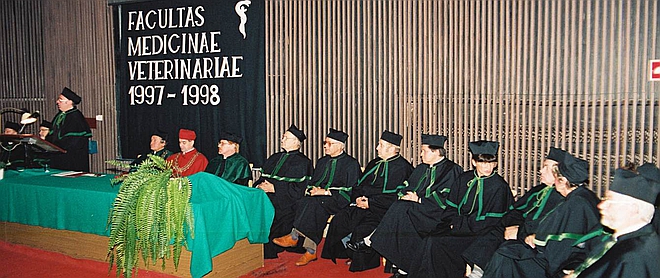
The history of the Faculty of Veterinary Medicine in Olsztyn dates back to the 1960s. Upon the request of the Academic Senate of the Higher School of Agriculture in Olsztyn, on 4 April 1966, the Minister of Science and Higher Education Professor Henryk Jabłoński passed a decree establishing the Division of Veterinary Science at the Faculty of Animal Production. The Clinical Hospital and the Division of Departments of Epizootiology and Veterinary Prevention were founded three months later, on 2 July 1966, and the first academic year began on 1 October of the same year. Thirty students were enrolled in the first academic program at the Division of Veterinary Science. The division employed sixteen members of academic staff who were supervised by the Deputy Dean of the Faculty of Animal Production Doc. Stefan Tarczyński. The members of the academic staff were: Prof. Kazimierz Kalinowski, Prof. Tadeusz Krzymowski, Prof. Robert Towarnicki, Prof. Janina Wengris, Doc. Remigiusz Fitko, Doc. Zofia Kalinowska, Doc. Wiesław Krautforst, Doc. Kazimierz Markiewicz, Doc. Wacław Minakowski, Doc. Zdzisław Larski, Doc. Wiktor Stefaniak, Doc. Tadeusz Szuperski, Zofia Markiewicz, Ph.D., Krystyna Wyrzykowska, Ph.D., and Zygmunt Wyrzykowski, Ph.D.
The following year was a pivotal moment in the history of the Faculty of Veterinary Medicine in Olsztyn. On 28 August 1967, the Minister of Science and Higher Education Professor Henryk Jabłoński passed a resolution which separated the Division of Veterinary Science from the Faculty of Animal Production and established an independent Faculty of Veterinary Science at the Higher School of Agriculture in Olsztyn. The resolution came into effect on 1 September 1967. On 4 October 1967, during the opening ceremony of the first academic year, Dean Stefan Tarczyński took an oath of office and stated that "the Faculty, the Faculty Board, the employees, and the students will make every effort to rise to scientific, academic, and educational challenges". In 1967, the Faculty employed one professor, seven docents, two assistant professors, one senior assistant, four assistants, five junior assistants, and six technical support and administration officers. The Faculty of Veterinary Science comprised the Division of Departments of Epizootiology and Veterinary Prevention, including the Department of Pathological Anatomy, Department of Veterinary Microbiology, Department of Parasitology and Invasive Diseases with a Clinic, and the Division of Basic Research in Animal Production and Veterinary Medicine, including the Department of Physiopathology, and the Clinical Hospital including the Department of Internal Diseases with a Clinic, the Department of Surgery with a Clinic, the Laboratory Diagnostics Unit, and the Department of Pharmacology and Toxicology.
The following years witnessed subsequent changes in the Faculty's organizational structure. In 1968, the Department of Anatomy was moved from the Faculty of Animal Production to the Faculty of Veterinary Science, and two new organizational units were created: the Histology and Embryology Laboratory, and the Department of Hygiene of Animal-Based Foods. The Department of Obstetrics and Reproduction Pathology was established in 1969, and the Department of Epizootiology with an Infectious Disease Clinic and the Poultry Disease Unit were created in 1970. In 1970, the Faculty employed 68 persons, including six professors (one full professor and five university professors), nine docents, ten assistant professors, nineteen senior assistants, four assistants, twenty technical support officers, and two administration officers. The Faculty had a total of 292 students. The Faculty offered also clinical services. In the 1970/1971 academic year, the Faculty's clinics treated a total of 1200 small animals and 2000 medium-sized and large animals. The Faculty continued to develop rapidly, and in 1968, it was authorized to confer the degree of doctor of veterinary medicine, and in 1971 – the degree of habilitated doctor of veterinary medicine.
The Faculty's organizational structure underwent subsequent changes in the 1970s. The following units were created: the Institute of Basic Veterinary Sciences, including Animal Anatomy, Histology and Embryology, Physiopathology, Pharmacology, and Toxicology; the Institute of Non-Infectious Diseases, including Internal Diseases, Surgery and Obstetrics; and the Institute of Infectious and Invasive Diseases, including Epizootiology, Parasitology and Invasive Diseases, Veterinary Microbiology, Pathological Anatomy and Poultry Diseases. The Department of Hygiene of Animal-Based Products was a separate organizational unit at the Faculty of Veterinary Science.
In the 1980/1981 academic year, the Faculty had 172 employees and 712 students (including 139 women). Rapid development prompted the Faculty to expand its premises and academic facilities. The construction of the first building hosting the Institute of Non-Infectious Diseases began in 1975, and the building was commissioned for use in 1979. The construction of the building hosting the Institute of Infectious and Invasive Diseases began in 1980. The first part of the building was put into operation in 1985, and the second part (hosting the Department of Animal Anatomy) was commissioned for use in 1987. New organizational units were also established in the 1980s and 1990s. The Hygiene and Veterinary Prevention Unit was created in 1980; the Unit of Forensic Veterinary Medicine and Administration was founded in 1988, and the Department of Clinical Physiology opened in 1997.
In 1994, the Faculty was renamed to the Faculty of Veterinary Medicine. The 1990s were a period of rapid growth during which the Faculty adapted to the new political reality and built recognition in the international arena. The Faculty established cooperation with the leading academic centers in the world, expanded its research facilities, and organized international scientific conferences.
The first visit of a group of experts from the European Association of Establishments for Veterinary Education (EAEVE) took place in 1999. In 2005, the Faculty of Veterinary Medicine was accredited by the EAEVE for compliance with quality standards in veterinary education in the European Union. In 2013, the accreditation was extended until 2022.